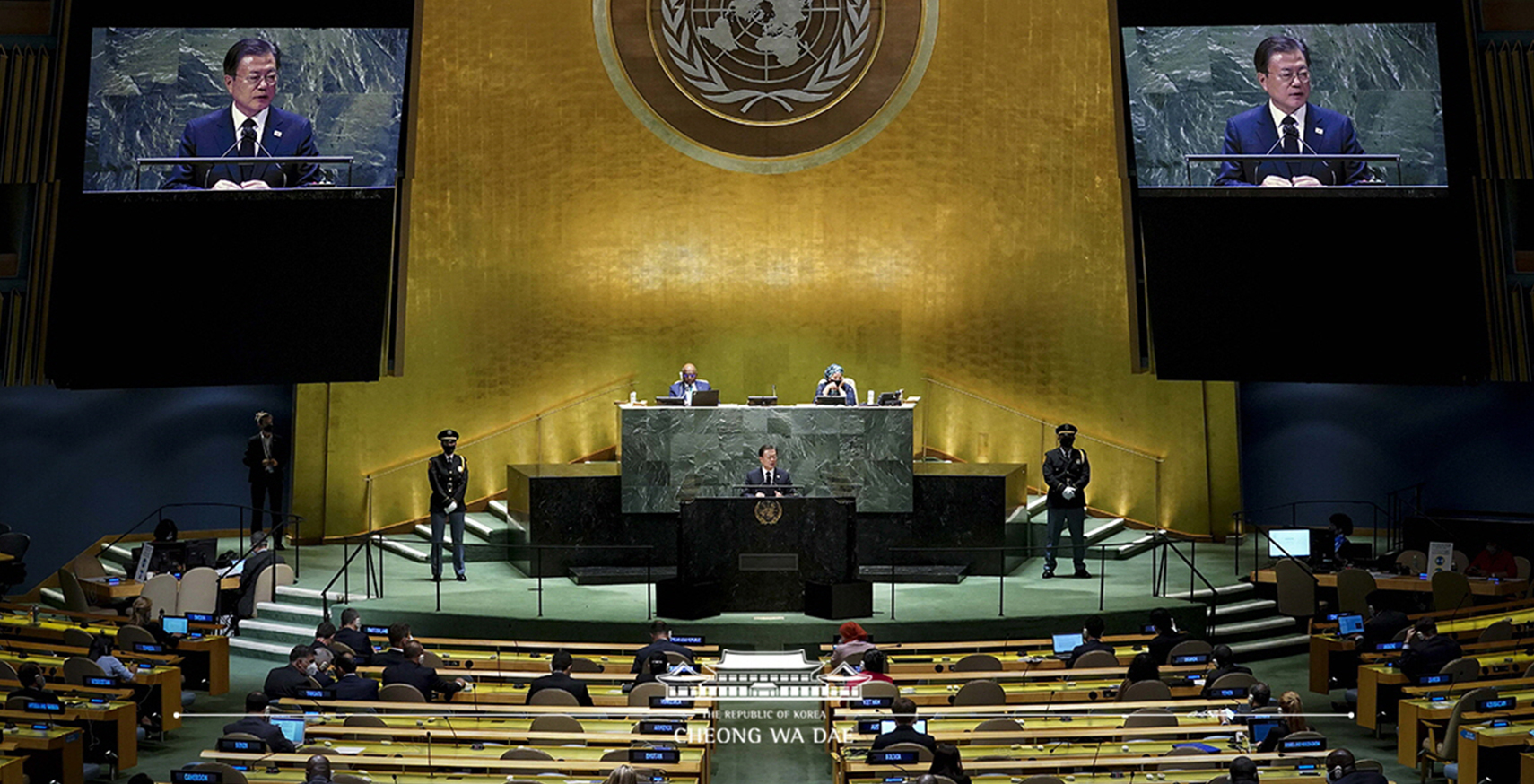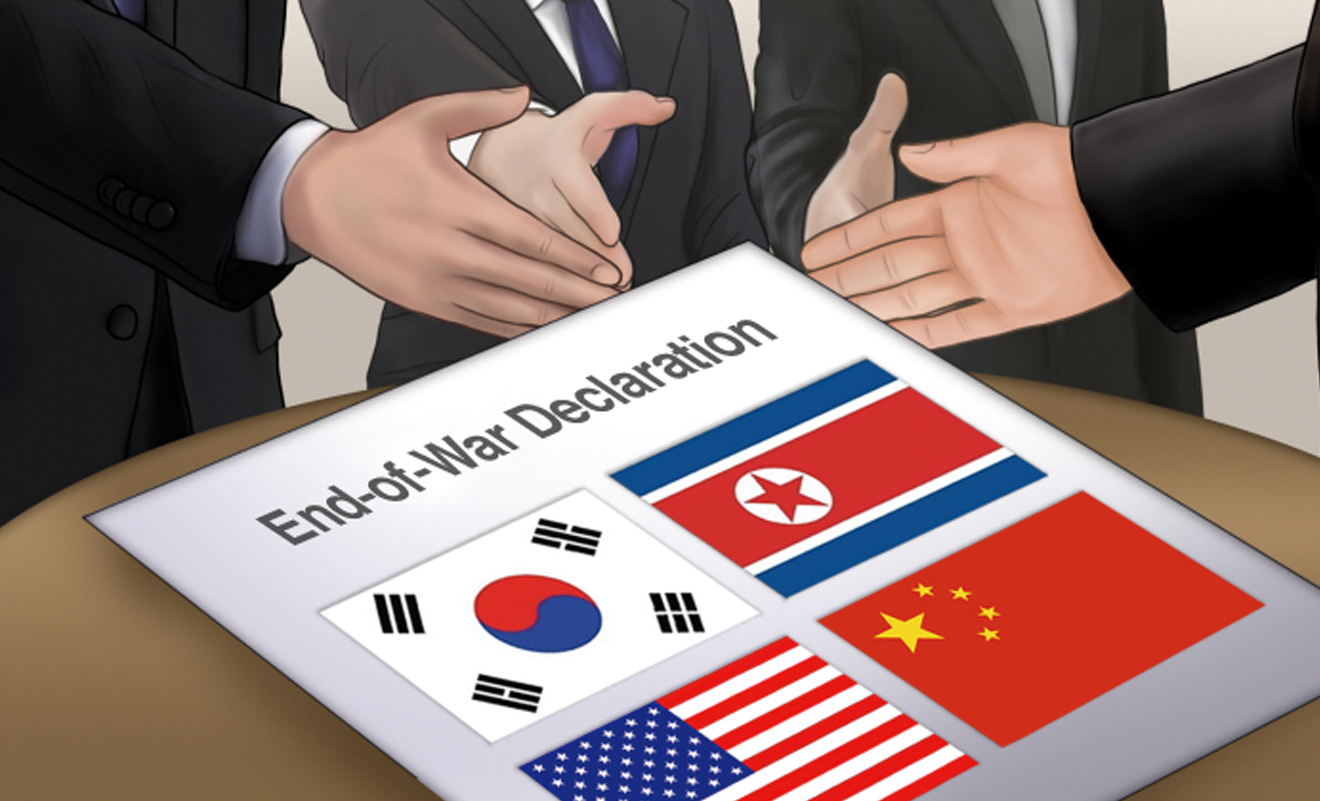November 2021

November 2021
At the U.N. General Assembly in New York, President Moon Jae-in once again called for the community of nations to come together and declare an end to the war on the Korean Peninsula. The South Korean leader believes that only when countries work together to end the war will peace be firmly established on the peninsula and, furthermore, prosperity fostered across all of Northeast Asia.
Written by
Sohn Ji-ae
Photo courtesy of
Cheong Wa Dae
 President Moon Jae-in on Sept. 21 delivers a keynote speech at U.N. headquarters in New York. © Cheong Wa Dae
President Moon Jae-in on Sept. 21 delivers a keynote speech at U.N. headquarters in New York. © Cheong Wa Dae
A denuclearized, co-prosperous Korean Peninsula has been one of President Moon Jae-in’s chief ambitions. Since he took office, President Moon has steadily and unwaveringly carried forward the Korean Peninsula peace process.
Some of the historic milestones achieved under his administration include the Panmunjeom Declaration resulting from the inter-Korean Summit in April 2018, the Singapore Declaration from the first-ever U.S.-North Korea Summit in June 2018, and the Pyongyang Joint Declaration of September 2018 signed by both Koreas.
Dialogue, however, has since then long been stalled because of disagreements among the parties involved―the two Koreas and the U.S.―over conditions for denuclearization, and worse, due to the prolonged COVID-19 pandemic.
Despite adverse conditions, President Moon didn’t stop his ambitious peace process.
Addressing world leaders at the 76th session of the U.N. General Assembly in New York on Sept. 21, President Moon once again set the stage for resuming the peace process, calling for support from the international community to join forces to achieve peace and prosperity on the Korean Peninsula.
“Today, I once again urge the community of nations to mobilize its strengths for the end of war declaration on the Korean Peninsula and propose that three parties of the two Koreas and the U.S., or four parties of the two Koreas, the U.S. and China come together and declare that the war on the peninsula is over,” the president said.
The Korean leader believes in collective action that would lead to irreversible progress and, ultimately, what he had long dreamed of: an end to the war on the Korean Peninsula. “An end-of-war declaration will mark a pivotal point of departure in creating a new order of reconciliation and cooperation on the peninsula,” he said.
Following President Moon’s end-of-war declaration at the U.N., the U.S. government reacted by saying that Washington pursues “a calibrated, practical approach that seeks serious and sustained diplomacy with North Korea to make what we hope to be ‘tangible progress’ that increases the security of the U.S., our allies including South Korea, and our deployed forces.”
 South Korea urges the two Koreas, the U.S, and China to work together to end the war on the Korean Peninsula. © Yonhap News
South Korea urges the two Koreas, the U.S, and China to work together to end the war on the Korean Peninsula. © Yonhap News
In less than two weeks after President Moon’s U.N. keynote speech, signs of a thaw between the two Koreas emerged.
On Oct. 4, the two Koreas fully restored their military hotlines, which the North cut off in early August in protest against joint South Korea-U.S. military exercises, just days after reopening them for the first time in a year. With the restoration of the communication channels, all functions were restored, including landline calls and fax transmission for receiving and sending documents between military authorities on both sides.
The decision came days after North Korean leader Kim Jong Un announced that he is willing to restore severed inter-Korean hotlines, saying that the communication link is to “help realize the expectations and desire of the entire Korean nation for recovery and durable peace.”
The U.S. government, too, welcomed the news, calling the reconnected lines “an important component in creating a more stable environment on the Korean Peninsula.”
With hopes for inter-Korean dialogue high, many expect that the latest move would lead to substantive easing of military tension in the region and even the resumption of negotiations not only between the two Koreas, but also between the U.S. and North Korea.
Finding a more effective solution to address conflicts of interest among the countries involved remains a big task for President Moon, whose term will end in May next year. President Moon vowed that he would make ceaseless efforts until his very last day in office.
One thing that is clear to him is that bringing the North back to the table can be done only through inter-Korean and international cooperation. In this sense, the recently resumed inter-Korean communication channels are a positive sign for breaking the prolonged stalemate that has been hindering President Moon’s peace process.